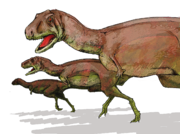
Rio Colorado Formation
Encyclopedia
The Rio Colorado Formation is a Mesozoic
geologic formation. Dinosaur
remains diagnostic to the genus
level are among the fossils that have been recovered from the formation.
Mesozoic
The Mesozoic era is an interval of geological time from about 250 million years ago to about 65 million years ago. It is often referred to as the age of reptiles because reptiles, namely dinosaurs, were the dominant terrestrial and marine vertebrates of the time...
geologic formation. Dinosaur
Dinosaur
Dinosaurs are a diverse group of animals of the clade and superorder Dinosauria. They were the dominant terrestrial vertebrates for over 160 million years, from the late Triassic period until the end of the Cretaceous , when the Cretaceous–Paleogene extinction event led to the extinction of...
remains diagnostic to the genus
Genus
In biology, a genus is a low-level taxonomic rank used in the biological classification of living and fossil organisms, which is an example of definition by genus and differentia...
level are among the fossils that have been recovered from the formation.
Ornithischians
| Ornithischians reported from the Rio Colorado Formation | ||||||
|---|---|---|---|---|---|---|
| Genus | Species | Province | Stratigraphic position | Material | Notes | Images |
Gasparinisaura Gasparinisaura Gasparinisaura is a genus of ornithopod dinosaur from the Late Cretaceous. Its fossils were found in Argentina. The type species, Gasparinisaura cincosaltensis, was described in 1996 by Coria and Salgado. Originally classified as an iguanodont, recent research indicates it is more basal... |
G. cincosaltensis |
|
"Skull and postcranial skeleton, postcranial elements, juvenile to subadult." |
 |
||
Sauropods
Titanosaur eggs are known from Neuquen province.| Sauropods reported from the Rio Colorado Formation | ||||||
|---|---|---|---|---|---|---|
| Genus | Species | Province | Stratigraphic position | Material | Notes | Images |
Antarctosaurus Antarctosaurus Antarctosaurus is a genus of titanosaurian sauropod dinosaur from the Late Cretaceous Period of what is now South America. The type species, A. wichmannianus, was described by prolific German paleontologist Friedrich von Huene in 1929, who also described a second species in 1929. Three additional... |
A. wichmannianus |
|
 |
|||
Argyrosaurus Argyrosaurus Argyrosaurus is a genus of herbivorous titanosaurid dinosaur that lived about 90 million years ago, during the Late Cretaceous Period of what is now South America . It was one of the largest dinosaurs, having a length of up to 20–30 metres and a weight estimated as high as eighty tonnes... |
Indeterminate |
|
||||
|
Loricosaurus |
L. scutatus |
|
||||
|
Macrurosaurus Macrurosaurus Macrurosaurus is the name given to a genus of dinosaur from the Early Cretaceous. It was a titanosauriform which lived in what is now Europe.... |
Indeterminate |
|
||||
|
Microcoelus |
M. patagonicus |
|
||||
|
Neuquensaurus Neuquensaurus Neuquensaurus is a genus of saltasaurid sauropod dinosaur that appeared in the Late Cretaceous, 71 million years ago in Argentina and Uruguay in South America... |
N. australis |
|
||||
|
Saltasaurus Saltasaurus Saltasaurus is a genus of titanosaurid sauropod dinosaur of the Late Cretaceous Period. Relatively small among sauropods, though still massive by the standards of modern creatures, Saltasaurus was characterized by a diplodocid-like head... |
S. robustus |
|
||||
|
Titanosaurus Titanosaurus Titanosaurus is a genus of sauropod dinosaur, first described by Lydekker in 1877. It is known from the Maastrichtian Lameta Formation of India... |
T. nanus |
|
||||
Theropods
| Theropods reported from the Rio Colorado Formation | ||||||
|---|---|---|---|---|---|---|
| Genus | Species | Province | Stratigraphic position | Material | Notes | Images |
Abelisaurus Abelisaurus Abelisaurus is a genus of abelisaurid theropod dinosaur from the Late Cretaceous Period of what is now South America. It was a bipedal carnivore that probably reached 7 to 9 meters in length, although it is known from only one partial skull.The generic name recognizes Roberto Abel as the... |
A. comahuaensis |
|
"Partial skull." |
 |
||
Alvarezsaurus Alvarezsaurus Alvarezsaurus is a genus of small alvarezsaurid dinosaur from the Late Cretaceous period of Argentina, approximately 86 - 83 million years ago. Estimates suggest that it measured about 2 meters in length and weighed approximately 20 kg... |
A. calvoi |
|
"Partial postcranial skeleton." |
|||
Aucasaurus Aucasaurus Aucasaurus was a genus of medium-sized theropod dinosaur from Argentina that lived during the Santonian stage . It was smaller than the related Carnotaurus, although more derived in some ways, such as its extremely reduced arms and almost total lack of fingers.The type skeleton is complete to the... |
A. garridoi |
|
"Nearly complete skeleton." |
|||
Neuquenornis Neuquenornis Neuquenornis volans was an enantiornithine bird which lived during the Late Cretaceous in today's Patagonia, Argentina. It is presently the only known species of the genus Neuquenornis. Its fossils were found in the Santonian Bajo de la Carpa Formation, dating from about 85-83 million years ago.... |
N. volans |
|
"Partial skeleton." |
|||
Patagopteryx Patagopteryx Patagopteryx is an extinct monotypic genus of birds that lived during the Late Cretaceous, around 80 mya, in what is now the Sierra Barrosa in northwestern Patagonia, Argentina. About the size of a chicken, it is the earliest known unequivocal example of secondary flightlessness: its skeleton... |
P. deferrariisi |
|
"Many skeletons." |
|||
Velocisaurus Velocisaurus Velocisaurus is a genus of ceratosaurian theropod dinosaur from the Cretaceous period of Argentina.In 1985 Oscar de Ferrariis and Zulma Gasparini uncovered fossils at Boca del Sapo in Neuquén province of Patagonia from layers of the Bajo de la Carpa Formation, dating from the Santonian. Among them... |
V. unicus |
|
"Partial hind limb." |
|||
See also
- List of stratigraphic units with dinosaur body fossils
- List of stratigraphic units with dinosaur trace fossils

